Analyzing Nike's Marketing Budget Allocation and Strategic Performance
VerifiedAdded on 2020/05/04
|28
|5556
|452
AI Summary
The task focuses on a comprehensive examination of Nike's marketing strategy through the lens of their budget allocation across different media channels, advertising campaigns, and promotional activities. By leveraging data from financial reports, consumer behavior studies, and market performance metrics, students will assess how effectively Nike's strategic choices contribute to its brand equity and competitive advantage. The analysis should consider traditional media versus digital platforms, the role of innovative marketing tactics like athlete endorsements, and the alignment between budget allocation and business objectives. Additionally, the assignment explores consumer response mechanisms, such as customer satisfaction and identification with the brand, and how these factors influence Nike's overall market performance. Key insights from authoritative sources will be utilized to support arguments, providing a well-rounded perspective on Nike’s marketing efficacy.

Running head: MARKETING STRATEGY
Marketing strategy
Name of student
Name of University
Author note
Marketing strategy
Name of student
Name of University
Author note
Paraphrase This Document
Need a fresh take? Get an instant paraphrase of this document with our AI Paraphraser
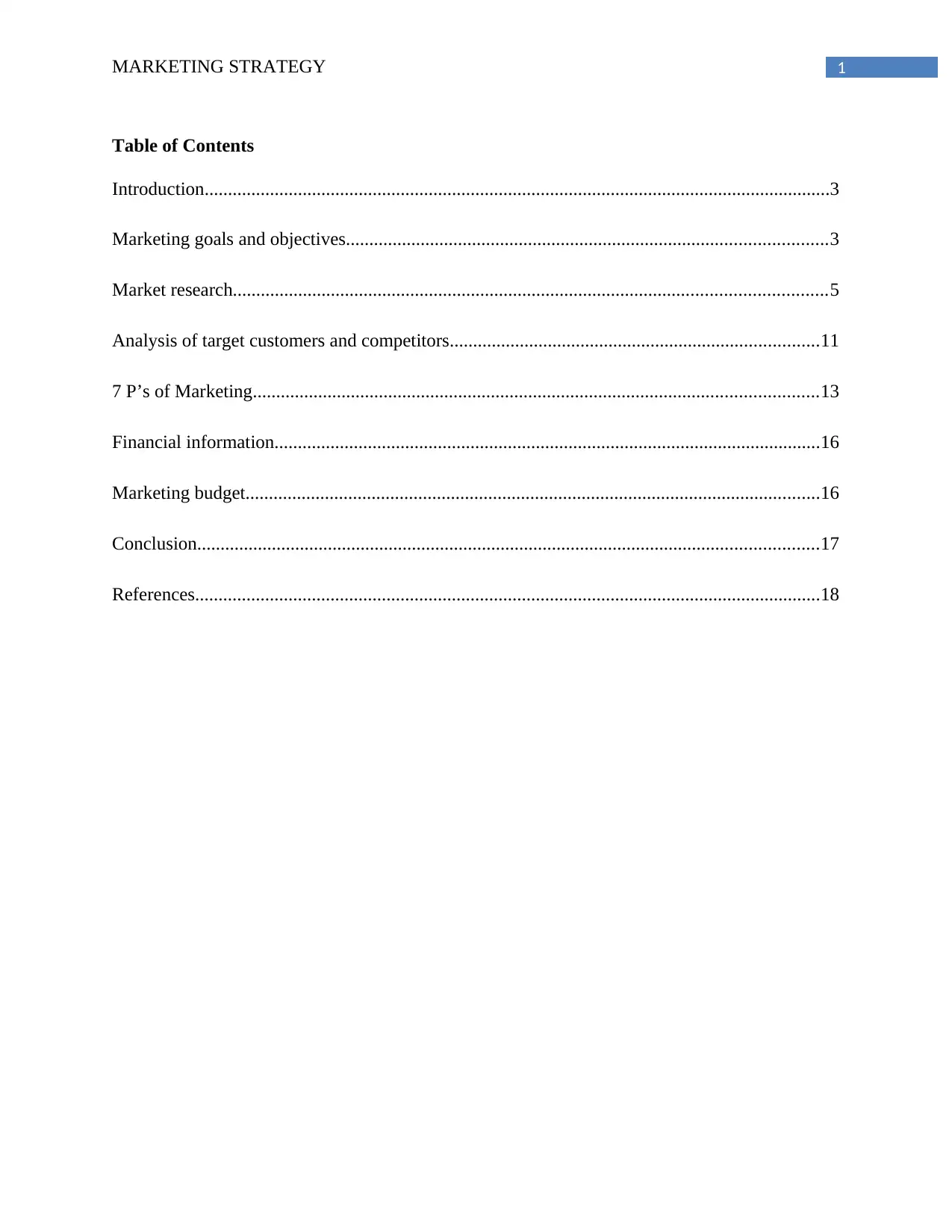
1MARKETING STRATEGY
Table of Contents
Introduction......................................................................................................................................3
Marketing goals and objectives.......................................................................................................3
Market research...............................................................................................................................5
Analysis of target customers and competitors...............................................................................11
7 P’s of Marketing.........................................................................................................................13
Financial information.....................................................................................................................16
Marketing budget...........................................................................................................................16
Conclusion.....................................................................................................................................17
References......................................................................................................................................18
Table of Contents
Introduction......................................................................................................................................3
Marketing goals and objectives.......................................................................................................3
Market research...............................................................................................................................5
Analysis of target customers and competitors...............................................................................11
7 P’s of Marketing.........................................................................................................................13
Financial information.....................................................................................................................16
Marketing budget...........................................................................................................................16
Conclusion.....................................................................................................................................17
References......................................................................................................................................18
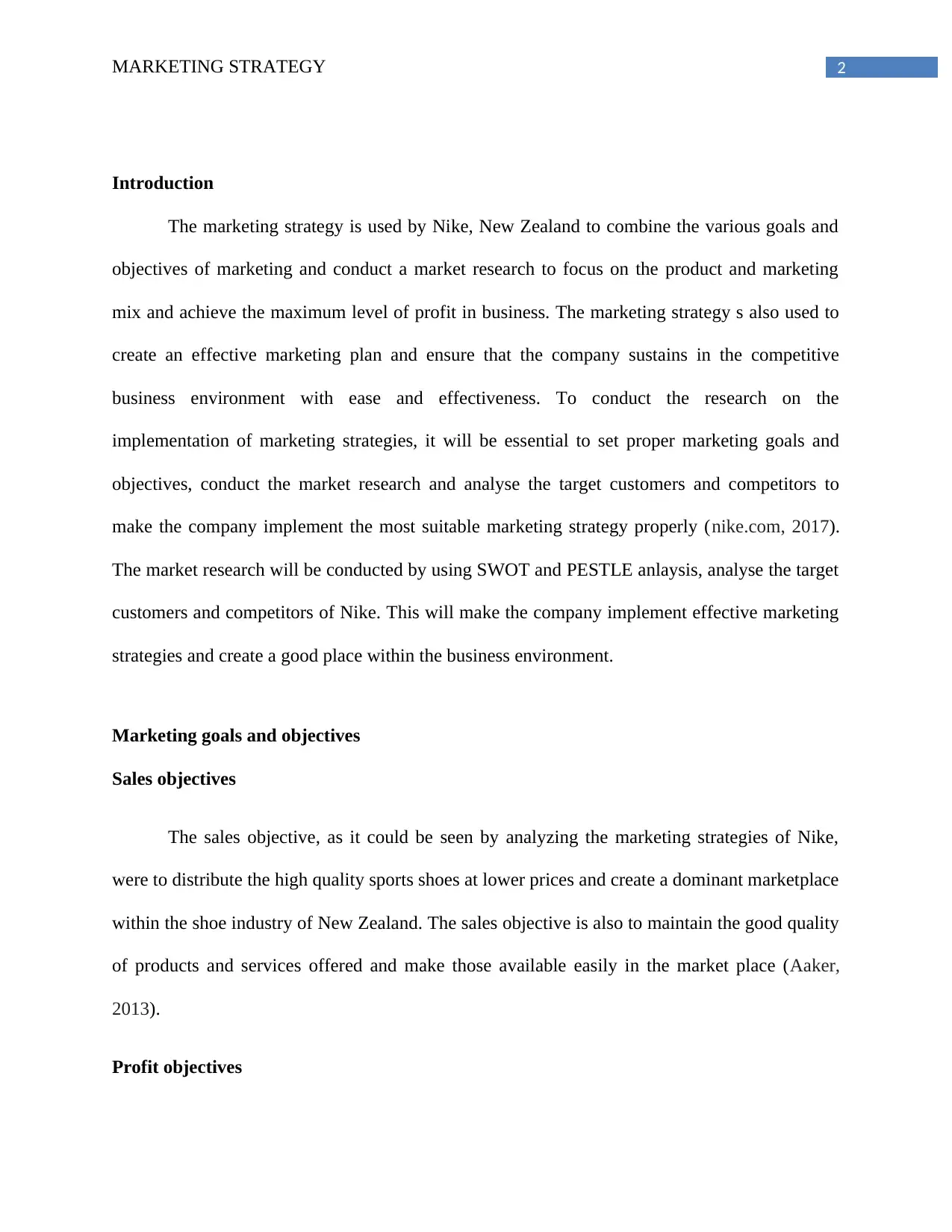
2MARKETING STRATEGY
Introduction
The marketing strategy is used by Nike, New Zealand to combine the various goals and
objectives of marketing and conduct a market research to focus on the product and marketing
mix and achieve the maximum level of profit in business. The marketing strategy s also used to
create an effective marketing plan and ensure that the company sustains in the competitive
business environment with ease and effectiveness. To conduct the research on the
implementation of marketing strategies, it will be essential to set proper marketing goals and
objectives, conduct the market research and analyse the target customers and competitors to
make the company implement the most suitable marketing strategy properly (nike.com, 2017).
The market research will be conducted by using SWOT and PESTLE anlaysis, analyse the target
customers and competitors of Nike. This will make the company implement effective marketing
strategies and create a good place within the business environment.
Marketing goals and objectives
Sales objectives
The sales objective, as it could be seen by analyzing the marketing strategies of Nike,
were to distribute the high quality sports shoes at lower prices and create a dominant marketplace
within the shoe industry of New Zealand. The sales objective is also to maintain the good quality
of products and services offered and make those available easily in the market place (Aaker,
2013).
Profit objectives
Introduction
The marketing strategy is used by Nike, New Zealand to combine the various goals and
objectives of marketing and conduct a market research to focus on the product and marketing
mix and achieve the maximum level of profit in business. The marketing strategy s also used to
create an effective marketing plan and ensure that the company sustains in the competitive
business environment with ease and effectiveness. To conduct the research on the
implementation of marketing strategies, it will be essential to set proper marketing goals and
objectives, conduct the market research and analyse the target customers and competitors to
make the company implement the most suitable marketing strategy properly (nike.com, 2017).
The market research will be conducted by using SWOT and PESTLE anlaysis, analyse the target
customers and competitors of Nike. This will make the company implement effective marketing
strategies and create a good place within the business environment.
Marketing goals and objectives
Sales objectives
The sales objective, as it could be seen by analyzing the marketing strategies of Nike,
were to distribute the high quality sports shoes at lower prices and create a dominant marketplace
within the shoe industry of New Zealand. The sales objective is also to maintain the good quality
of products and services offered and make those available easily in the market place (Aaker,
2013).
Profit objectives
⊘ This is a preview!⊘
Do you want full access?
Subscribe today to unlock all pages.

Trusted by 1+ million students worldwide
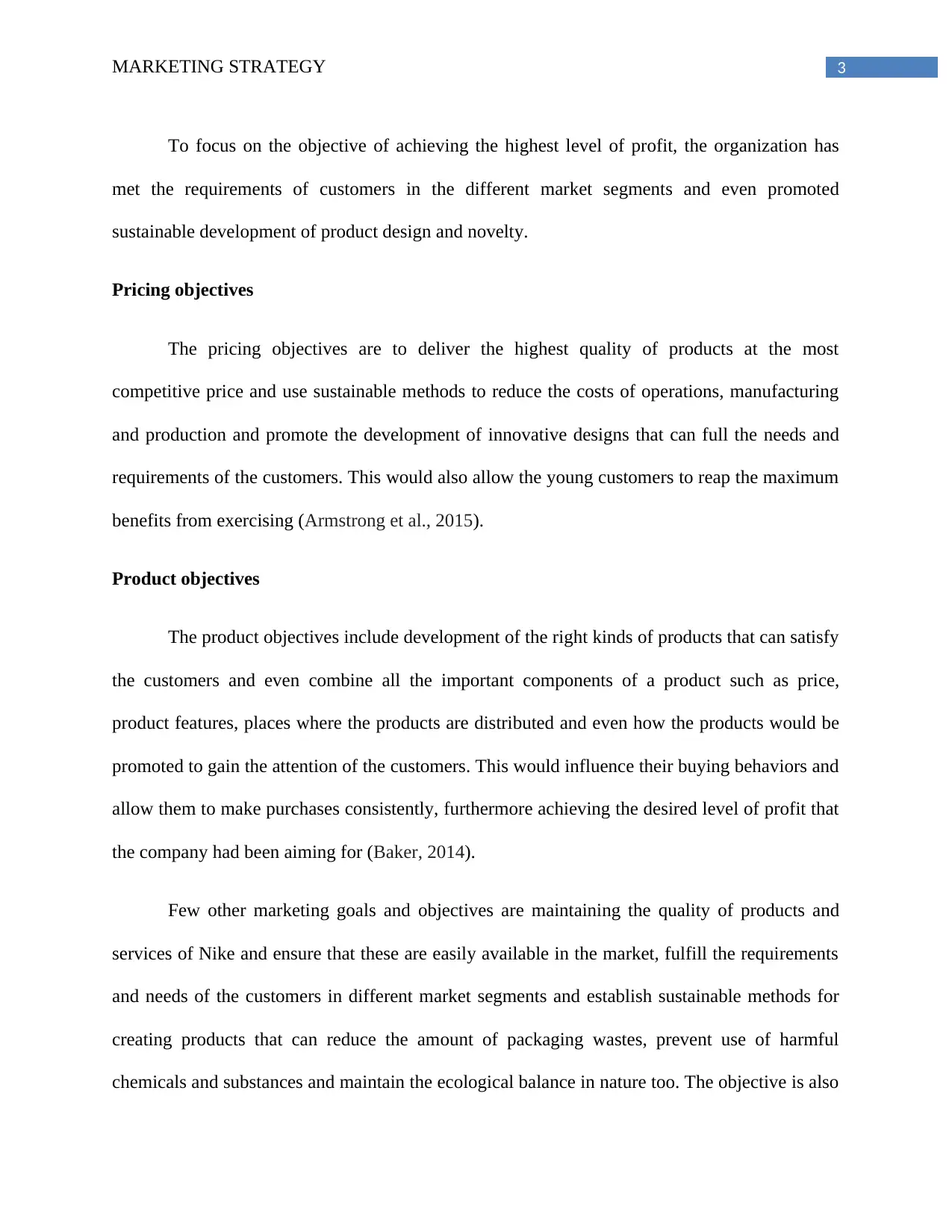
3MARKETING STRATEGY
To focus on the objective of achieving the highest level of profit, the organization has
met the requirements of customers in the different market segments and even promoted
sustainable development of product design and novelty.
Pricing objectives
The pricing objectives are to deliver the highest quality of products at the most
competitive price and use sustainable methods to reduce the costs of operations, manufacturing
and production and promote the development of innovative designs that can full the needs and
requirements of the customers. This would also allow the young customers to reap the maximum
benefits from exercising (Armstrong et al., 2015).
Product objectives
The product objectives include development of the right kinds of products that can satisfy
the customers and even combine all the important components of a product such as price,
product features, places where the products are distributed and even how the products would be
promoted to gain the attention of the customers. This would influence their buying behaviors and
allow them to make purchases consistently, furthermore achieving the desired level of profit that
the company had been aiming for (Baker, 2014).
Few other marketing goals and objectives are maintaining the quality of products and
services of Nike and ensure that these are easily available in the market, fulfill the requirements
and needs of the customers in different market segments and establish sustainable methods for
creating products that can reduce the amount of packaging wastes, prevent use of harmful
chemicals and substances and maintain the ecological balance in nature too. The objective is also
To focus on the objective of achieving the highest level of profit, the organization has
met the requirements of customers in the different market segments and even promoted
sustainable development of product design and novelty.
Pricing objectives
The pricing objectives are to deliver the highest quality of products at the most
competitive price and use sustainable methods to reduce the costs of operations, manufacturing
and production and promote the development of innovative designs that can full the needs and
requirements of the customers. This would also allow the young customers to reap the maximum
benefits from exercising (Armstrong et al., 2015).
Product objectives
The product objectives include development of the right kinds of products that can satisfy
the customers and even combine all the important components of a product such as price,
product features, places where the products are distributed and even how the products would be
promoted to gain the attention of the customers. This would influence their buying behaviors and
allow them to make purchases consistently, furthermore achieving the desired level of profit that
the company had been aiming for (Baker, 2014).
Few other marketing goals and objectives are maintaining the quality of products and
services of Nike and ensure that these are easily available in the market, fulfill the requirements
and needs of the customers in different market segments and establish sustainable methods for
creating products that can reduce the amount of packaging wastes, prevent use of harmful
chemicals and substances and maintain the ecological balance in nature too. The objective is also
Paraphrase This Document
Need a fresh take? Get an instant paraphrase of this document with our AI Paraphraser
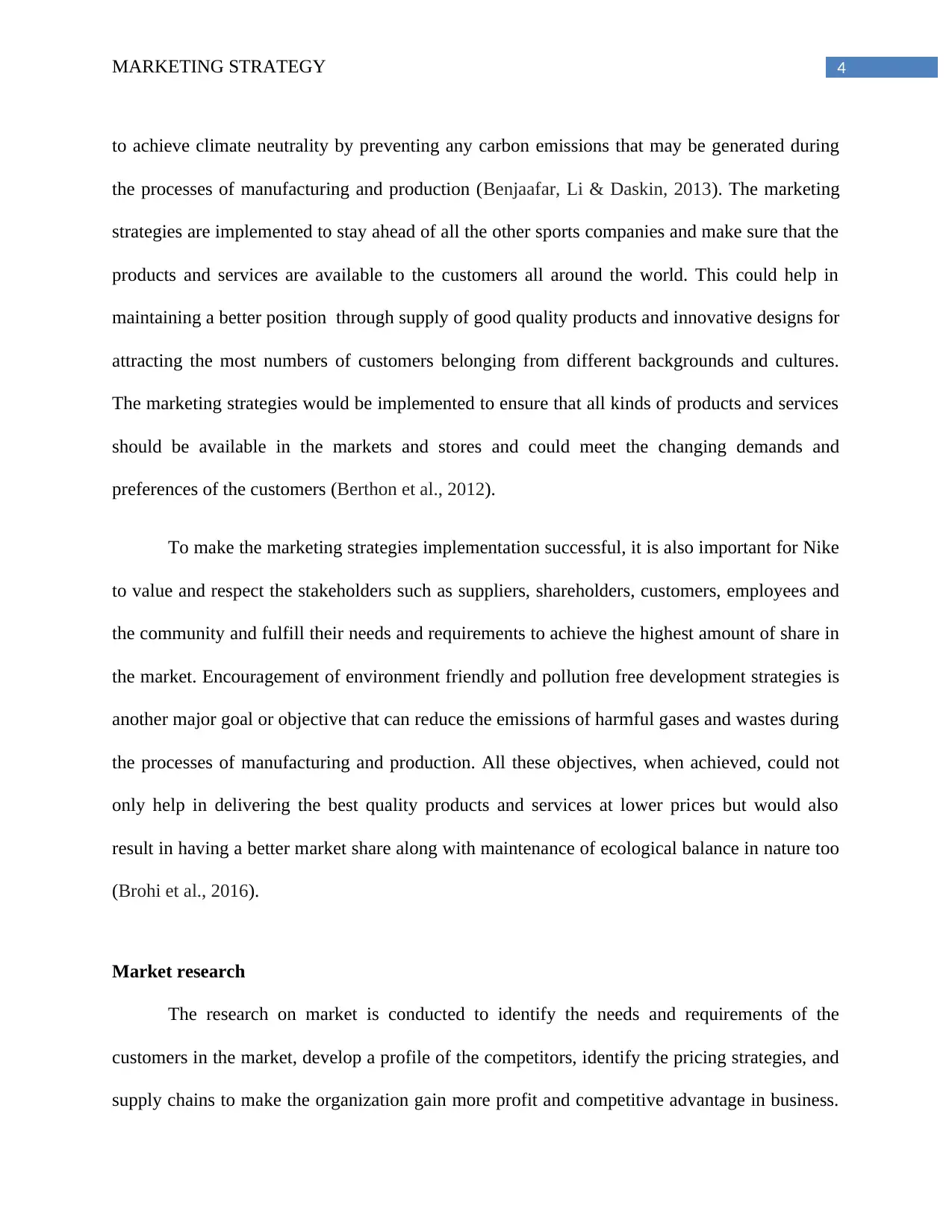
4MARKETING STRATEGY
to achieve climate neutrality by preventing any carbon emissions that may be generated during
the processes of manufacturing and production (Benjaafar, Li & Daskin, 2013). The marketing
strategies are implemented to stay ahead of all the other sports companies and make sure that the
products and services are available to the customers all around the world. This could help in
maintaining a better position through supply of good quality products and innovative designs for
attracting the most numbers of customers belonging from different backgrounds and cultures.
The marketing strategies would be implemented to ensure that all kinds of products and services
should be available in the markets and stores and could meet the changing demands and
preferences of the customers (Berthon et al., 2012).
To make the marketing strategies implementation successful, it is also important for Nike
to value and respect the stakeholders such as suppliers, shareholders, customers, employees and
the community and fulfill their needs and requirements to achieve the highest amount of share in
the market. Encouragement of environment friendly and pollution free development strategies is
another major goal or objective that can reduce the emissions of harmful gases and wastes during
the processes of manufacturing and production. All these objectives, when achieved, could not
only help in delivering the best quality products and services at lower prices but would also
result in having a better market share along with maintenance of ecological balance in nature too
(Brohi et al., 2016).
Market research
The research on market is conducted to identify the needs and requirements of the
customers in the market, develop a profile of the competitors, identify the pricing strategies, and
supply chains to make the organization gain more profit and competitive advantage in business.
to achieve climate neutrality by preventing any carbon emissions that may be generated during
the processes of manufacturing and production (Benjaafar, Li & Daskin, 2013). The marketing
strategies are implemented to stay ahead of all the other sports companies and make sure that the
products and services are available to the customers all around the world. This could help in
maintaining a better position through supply of good quality products and innovative designs for
attracting the most numbers of customers belonging from different backgrounds and cultures.
The marketing strategies would be implemented to ensure that all kinds of products and services
should be available in the markets and stores and could meet the changing demands and
preferences of the customers (Berthon et al., 2012).
To make the marketing strategies implementation successful, it is also important for Nike
to value and respect the stakeholders such as suppliers, shareholders, customers, employees and
the community and fulfill their needs and requirements to achieve the highest amount of share in
the market. Encouragement of environment friendly and pollution free development strategies is
another major goal or objective that can reduce the emissions of harmful gases and wastes during
the processes of manufacturing and production. All these objectives, when achieved, could not
only help in delivering the best quality products and services at lower prices but would also
result in having a better market share along with maintenance of ecological balance in nature too
(Brohi et al., 2016).
Market research
The research on market is conducted to identify the needs and requirements of the
customers in the market, develop a profile of the competitors, identify the pricing strategies, and
supply chains to make the organization gain more profit and competitive advantage in business.
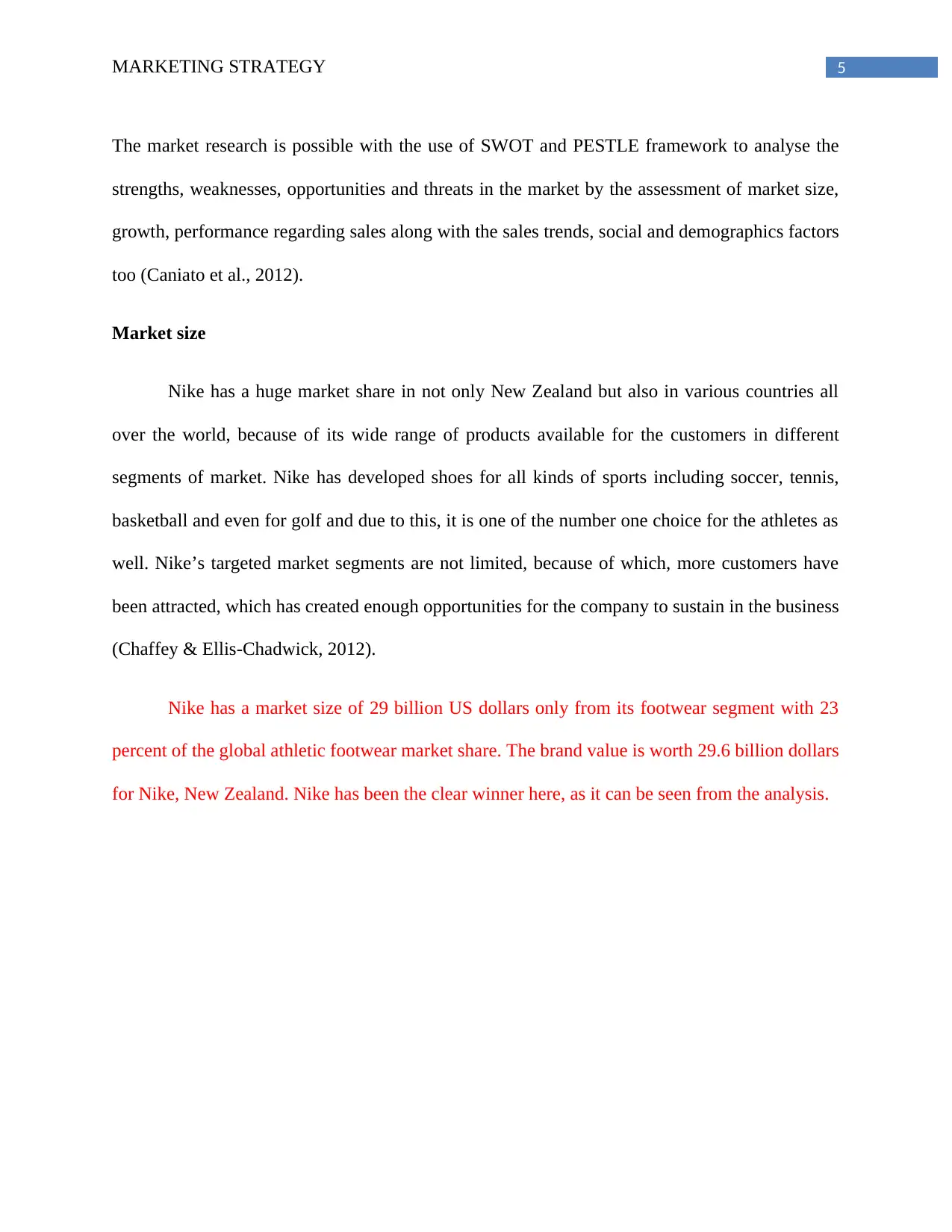
5MARKETING STRATEGY
The market research is possible with the use of SWOT and PESTLE framework to analyse the
strengths, weaknesses, opportunities and threats in the market by the assessment of market size,
growth, performance regarding sales along with the sales trends, social and demographics factors
too (Caniato et al., 2012).
Market size
Nike has a huge market share in not only New Zealand but also in various countries all
over the world, because of its wide range of products available for the customers in different
segments of market. Nike has developed shoes for all kinds of sports including soccer, tennis,
basketball and even for golf and due to this, it is one of the number one choice for the athletes as
well. Nike’s targeted market segments are not limited, because of which, more customers have
been attracted, which has created enough opportunities for the company to sustain in the business
(Chaffey & Ellis-Chadwick, 2012).
Nike has a market size of 29 billion US dollars only from its footwear segment with 23
percent of the global athletic footwear market share. The brand value is worth 29.6 billion dollars
for Nike, New Zealand. Nike has been the clear winner here, as it can be seen from the analysis.
The market research is possible with the use of SWOT and PESTLE framework to analyse the
strengths, weaknesses, opportunities and threats in the market by the assessment of market size,
growth, performance regarding sales along with the sales trends, social and demographics factors
too (Caniato et al., 2012).
Market size
Nike has a huge market share in not only New Zealand but also in various countries all
over the world, because of its wide range of products available for the customers in different
segments of market. Nike has developed shoes for all kinds of sports including soccer, tennis,
basketball and even for golf and due to this, it is one of the number one choice for the athletes as
well. Nike’s targeted market segments are not limited, because of which, more customers have
been attracted, which has created enough opportunities for the company to sustain in the business
(Chaffey & Ellis-Chadwick, 2012).
Nike has a market size of 29 billion US dollars only from its footwear segment with 23
percent of the global athletic footwear market share. The brand value is worth 29.6 billion dollars
for Nike, New Zealand. Nike has been the clear winner here, as it can be seen from the analysis.
⊘ This is a preview!⊘
Do you want full access?
Subscribe today to unlock all pages.

Trusted by 1+ million students worldwide
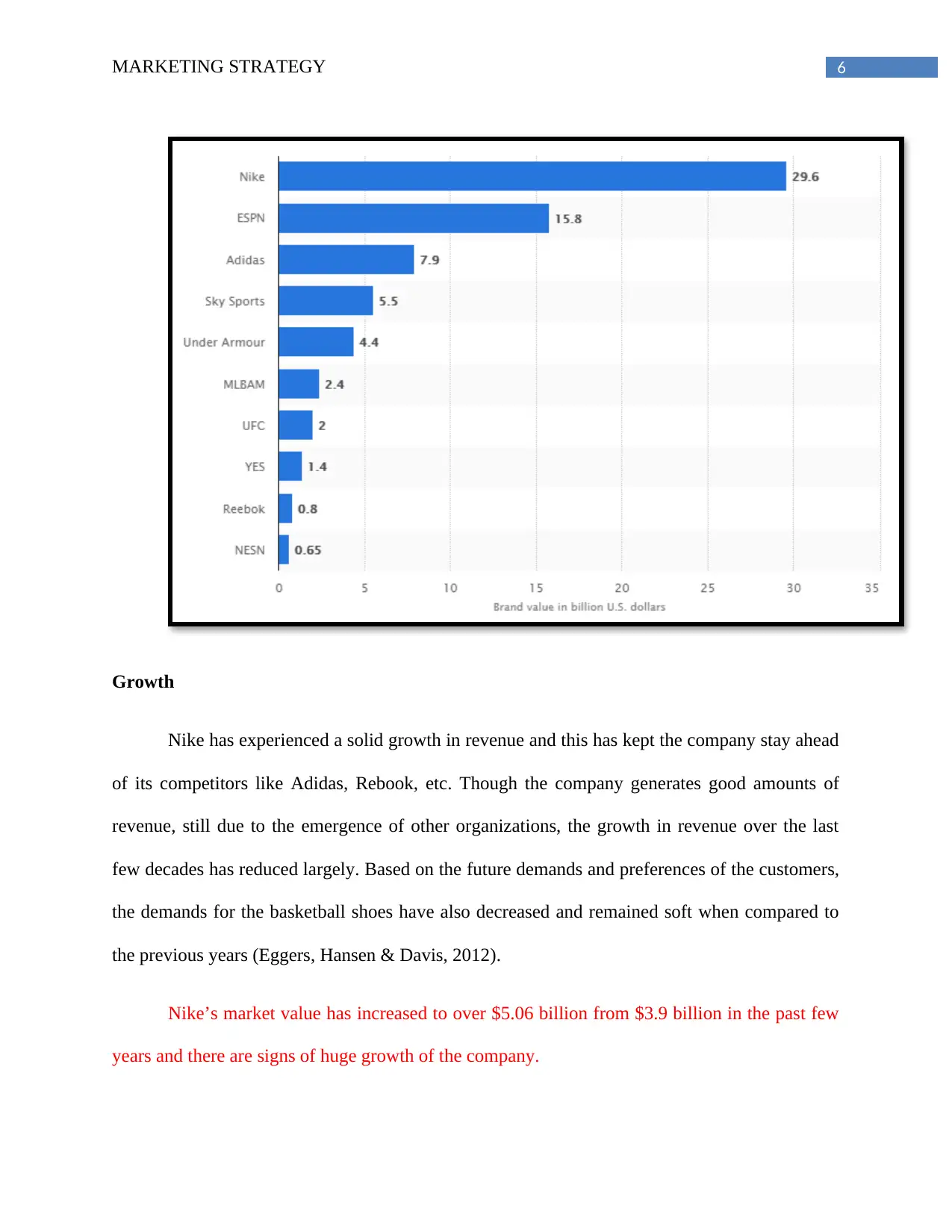
6MARKETING STRATEGY
Growth
Nike has experienced a solid growth in revenue and this has kept the company stay ahead
of its competitors like Adidas, Rebook, etc. Though the company generates good amounts of
revenue, still due to the emergence of other organizations, the growth in revenue over the last
few decades has reduced largely. Based on the future demands and preferences of the customers,
the demands for the basketball shoes have also decreased and remained soft when compared to
the previous years (Eggers, Hansen & Davis, 2012).
Nike’s market value has increased to over $5.06 billion from $3.9 billion in the past few
years and there are signs of huge growth of the company.
Growth
Nike has experienced a solid growth in revenue and this has kept the company stay ahead
of its competitors like Adidas, Rebook, etc. Though the company generates good amounts of
revenue, still due to the emergence of other organizations, the growth in revenue over the last
few decades has reduced largely. Based on the future demands and preferences of the customers,
the demands for the basketball shoes have also decreased and remained soft when compared to
the previous years (Eggers, Hansen & Davis, 2012).
Nike’s market value has increased to over $5.06 billion from $3.9 billion in the past few
years and there are signs of huge growth of the company.
Paraphrase This Document
Need a fresh take? Get an instant paraphrase of this document with our AI Paraphraser
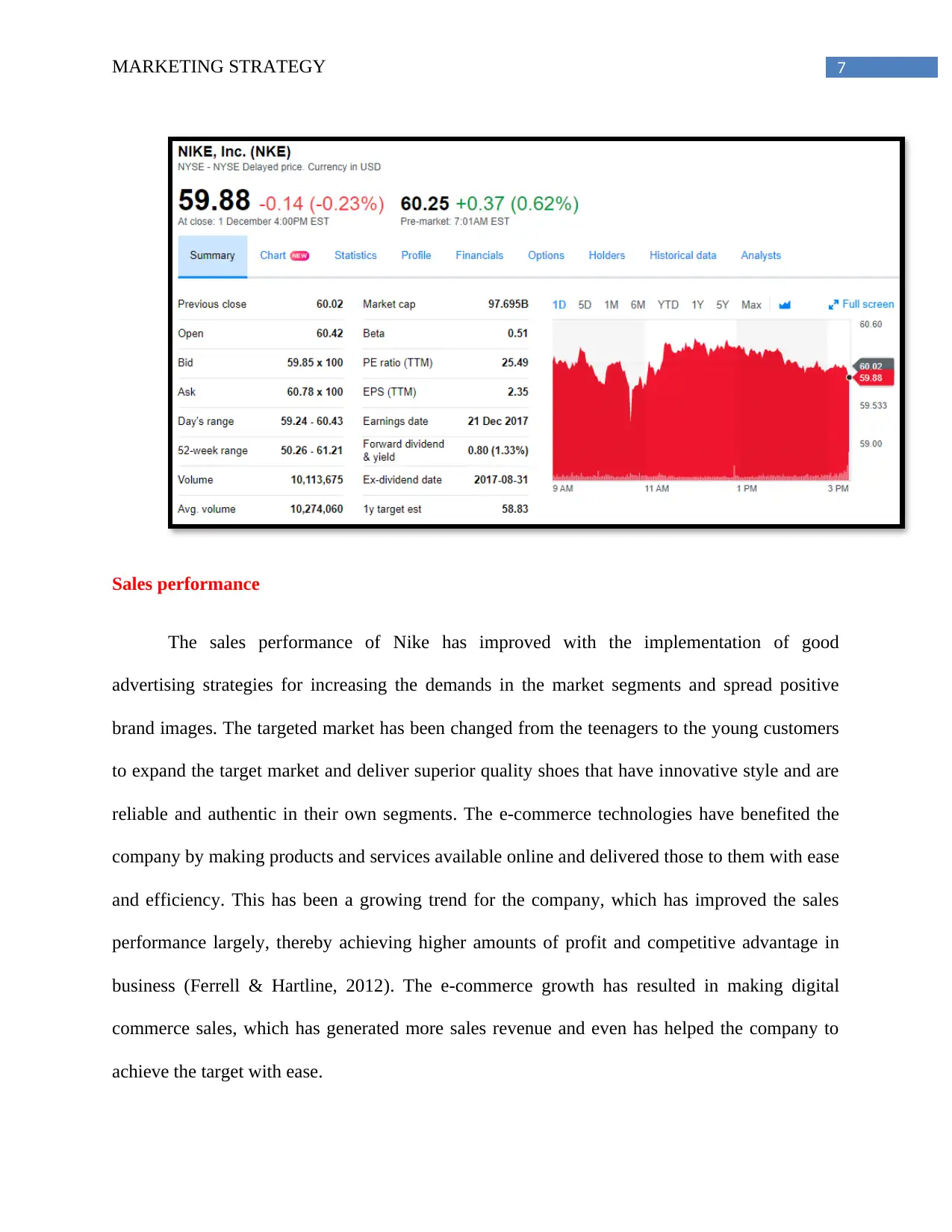
7MARKETING STRATEGY
Sales performance
The sales performance of Nike has improved with the implementation of good
advertising strategies for increasing the demands in the market segments and spread positive
brand images. The targeted market has been changed from the teenagers to the young customers
to expand the target market and deliver superior quality shoes that have innovative style and are
reliable and authentic in their own segments. The e-commerce technologies have benefited the
company by making products and services available online and delivered those to them with ease
and efficiency. This has been a growing trend for the company, which has improved the sales
performance largely, thereby achieving higher amounts of profit and competitive advantage in
business (Ferrell & Hartline, 2012). The e-commerce growth has resulted in making digital
commerce sales, which has generated more sales revenue and even has helped the company to
achieve the target with ease.
Sales performance
The sales performance of Nike has improved with the implementation of good
advertising strategies for increasing the demands in the market segments and spread positive
brand images. The targeted market has been changed from the teenagers to the young customers
to expand the target market and deliver superior quality shoes that have innovative style and are
reliable and authentic in their own segments. The e-commerce technologies have benefited the
company by making products and services available online and delivered those to them with ease
and efficiency. This has been a growing trend for the company, which has improved the sales
performance largely, thereby achieving higher amounts of profit and competitive advantage in
business (Ferrell & Hartline, 2012). The e-commerce growth has resulted in making digital
commerce sales, which has generated more sales revenue and even has helped the company to
achieve the target with ease.
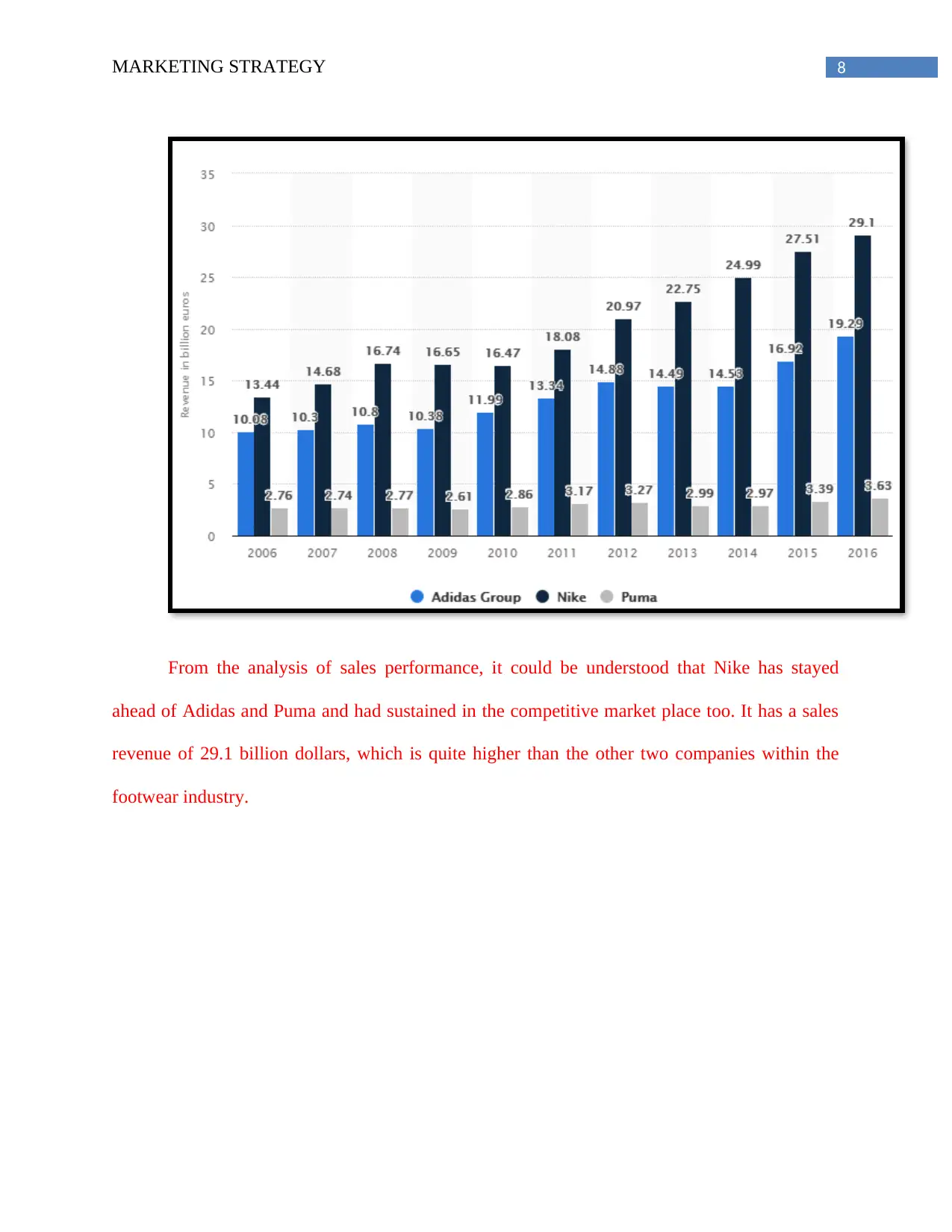
8MARKETING STRATEGY
From the analysis of sales performance, it could be understood that Nike has stayed
ahead of Adidas and Puma and had sustained in the competitive market place too. It has a sales
revenue of 29.1 billion dollars, which is quite higher than the other two companies within the
footwear industry.
From the analysis of sales performance, it could be understood that Nike has stayed
ahead of Adidas and Puma and had sustained in the competitive market place too. It has a sales
revenue of 29.1 billion dollars, which is quite higher than the other two companies within the
footwear industry.
⊘ This is a preview!⊘
Do you want full access?
Subscribe today to unlock all pages.

Trusted by 1+ million students worldwide
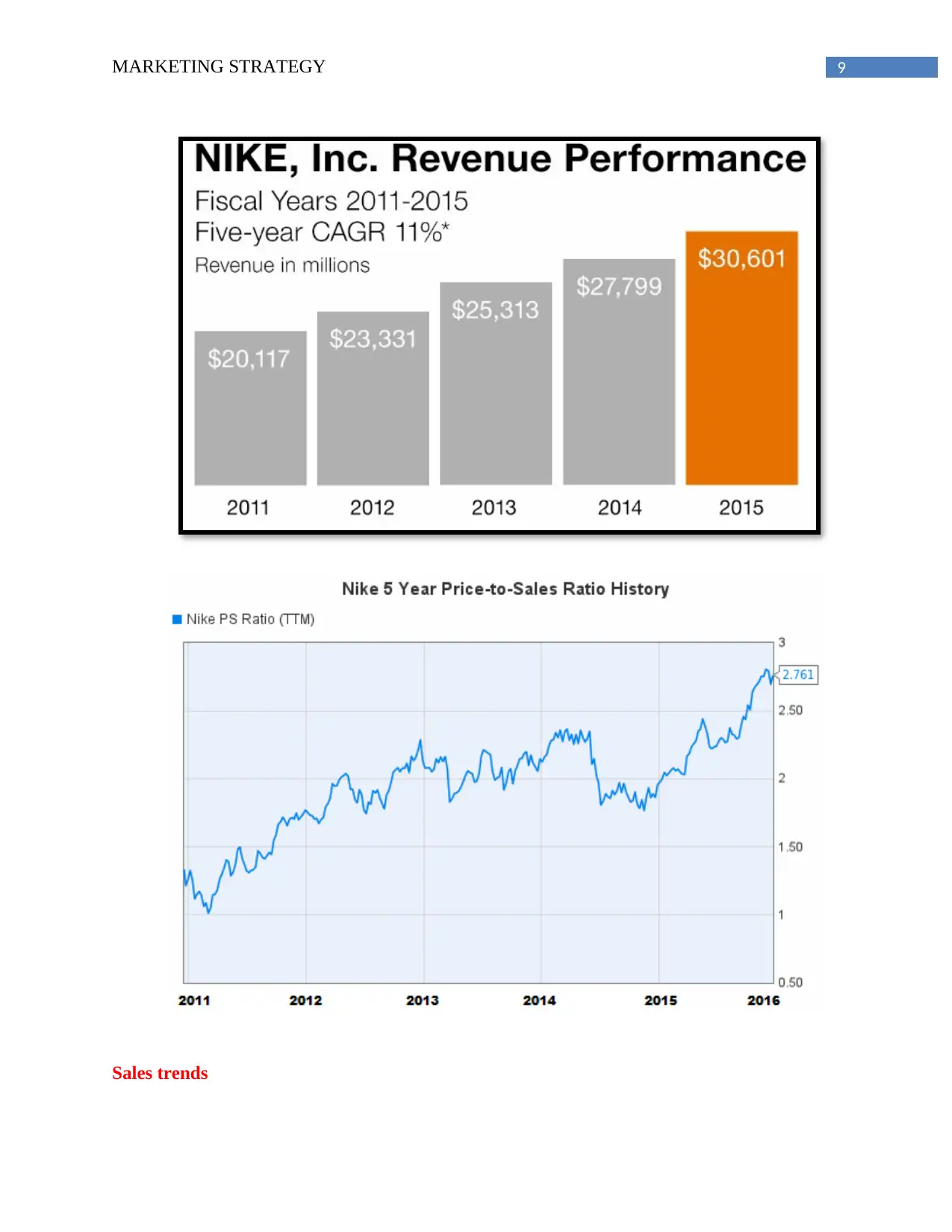
9MARKETING STRATEGY
Sales trends
Sales trends
Paraphrase This Document
Need a fresh take? Get an instant paraphrase of this document with our AI Paraphraser

10MARKETING STRATEGY
The sales of Nike have increased for the past few years hugely and it has not only resulted in
gaining good amounts of return, which is far more than the investments that were made earlier.
Based on the analysis of two years, though without considering the past few years, it could be
seen that the sales trends had increased potentially.
The sales of Nike have increased for the past few years hugely and it has not only resulted in
gaining good amounts of return, which is far more than the investments that were made earlier.
Based on the analysis of two years, though without considering the past few years, it could be
seen that the sales trends had increased potentially.
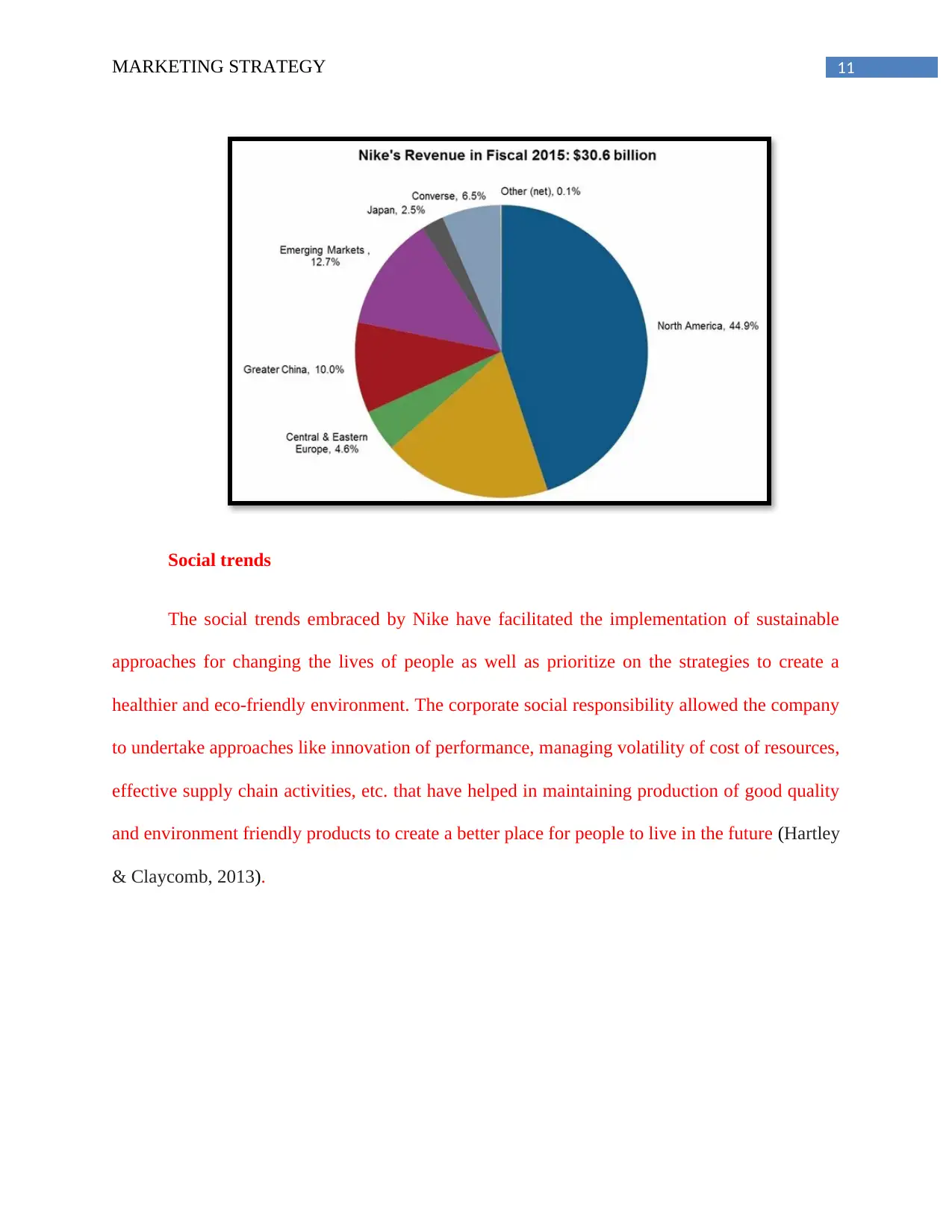
11MARKETING STRATEGY
Social trends
The social trends embraced by Nike have facilitated the implementation of sustainable
approaches for changing the lives of people as well as prioritize on the strategies to create a
healthier and eco-friendly environment. The corporate social responsibility allowed the company
to undertake approaches like innovation of performance, managing volatility of cost of resources,
effective supply chain activities, etc. that have helped in maintaining production of good quality
and environment friendly products to create a better place for people to live in the future (Hartley
& Claycomb, 2013).
Social trends
The social trends embraced by Nike have facilitated the implementation of sustainable
approaches for changing the lives of people as well as prioritize on the strategies to create a
healthier and eco-friendly environment. The corporate social responsibility allowed the company
to undertake approaches like innovation of performance, managing volatility of cost of resources,
effective supply chain activities, etc. that have helped in maintaining production of good quality
and environment friendly products to create a better place for people to live in the future (Hartley
& Claycomb, 2013).
⊘ This is a preview!⊘
Do you want full access?
Subscribe today to unlock all pages.

Trusted by 1+ million students worldwide
1 out of 28
Related Documents
Your All-in-One AI-Powered Toolkit for Academic Success.
+13062052269
info@desklib.com
Available 24*7 on WhatsApp / Email
![[object Object]](/_next/static/media/star-bottom.7253800d.svg)
Unlock your academic potential
Copyright © 2020–2025 A2Z Services. All Rights Reserved. Developed and managed by ZUCOL.





